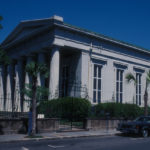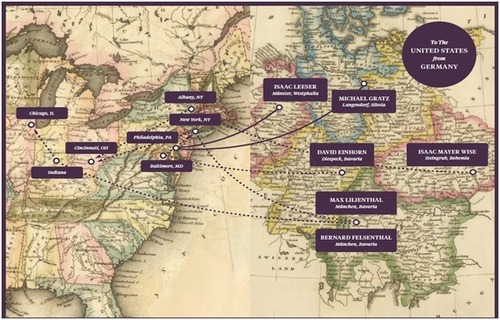Kahal Kadosh Beth Elohim, Charleston, South Carolina
By Nicole Siegel, Research Intern and Graduate Student at Fordham University
One of the oldest congregations in America, Kahal Kadosh Beth Elohim (KKBE) of Charleston, South Carolina, dates back to 1749 and is currently the fourth oldest congregation in the United States. Originally a Sephardic Orthodox Congregation, the community quickly embraced the ideas of Reform Judaism, becoming one of the birthplaces of Reform Judaism in America. Their synagogue building became a reflection of the changes that occurred in the Jewish community.
When KKBE built their synagogue, they built it in the Georgian style of the 1700s. The building’s exterior was designed to look like a church. Some scholars believe that KKBE was modeled after the churches designed by Christopher Wren, an influential church architect in England. Wren’s style also influenced the design of the Bevis Marks Synagogue in London, a contemporary Sephardic Orthodox synagogue built at the end of the 17th century(1). While the exterior design was reminiscent of church architecture, the interior reflected the interior of a traditional Sephardic synagogue. While there was a women’s gallery, the stairs leading to it were part of the exterior so women could walk to the balcony without having to go through the main part of the sanctuary. The main part of the sanctuary had the Ark facing one end of the wall and the Tevah, or platform from which the rabbi or cantor read from, on the opposite end of the wall, separated by a great hall(2). Surrounding the Ark and the Tevah were chairs which faced the middle of the room. One unique feature was the cupola, a dome like structure attached to a roof which was used primarily to admit light or air, which was designed to look like a Chinese garden pavilion. The Chinese garden design on the cupola was occasionally used in architecture in the 1700s as a decorative device to evoke images of the Orient(3). The Orient was a common theme in many Jewish buildings, reflecting the idea of the origins of the Jews as a Semitic race(4). The synagogue itself reflected the traditional nature of the congregation, one that was proud of its heritage as Jews and as Americans.
The proud nature of these Jews as both Jews and Americans was reflected in the struggle that occurred in the beginning of the 1800s. Some Jews wanted to remain traditional, while others wanted to reform the service. When the proposal to reform was turned down in 1824, those who wanted to reform left KKBE and created their own reform congregation, rejoining with the main congregation in 1833. This truce between the two groups lasted until 1838, when the synagogue burnt down in the fire of 1838.
In the next post we will look at the new synagogue that was built in 1838 after the fire.
For more information on KKBE, see the Records of KKBE in the American Jewish Historical Society collection, which includes hymns that the community wrote for their new service, a draft of a letter written by the community to congratulate George Washington on his presidency, architectural records , communal histories and brochures written about the community.
1: Kadish, Sharman. The Cathedral Synagogues of London. Jewish Historical Studies, Vol. 39 (2004), pp. 45-77 Sharman Kadish, “Constructing Identity: Anglo-Jewry and Synagogue Architecture,” Architectural History 45(2002).389; Gene Waddell, “An Architectural History of Kahal Kadosh Beth Elohim, Charleston,” The South Carolina Historical Magazine (1997).8-9;Breibart Solomon, “The Synagogues of Kahal Kadosh Beth Elohim, Charleston,” ibid.80, no. 3 (1979).215
2: Gene Waddell, “An Architectural History of Kahal Kadosh Beth Elohim, Charleston,” ibid.(1997).9
3: Waddel, Gene. An Architectural History of Kahal Kadosh Beth Elohim, Charleston, South Carolina Historical Magazine 12
4: Kalmar Ivan Davidson, “Moorish Style: Orientalism, the Jews, and Synagogue Architecture,” Jewish Social Studies 7, no. 3 (2001).72-74
Creative Commons user: JERRYE & ROY KLOTZ MD/KLOTZ
Sources I Used:
Ivan Davidson, Kalmar. “Moorish Style: Orientalism,
the Jews, and Synagogue Architecture.” Jewish Social Studies 7, no. 3
(2001): 68-100.
Kadish, Sharman. “Constructing Identity: Anglo-Jewry and Synagogue Architecture.” Architectural History 45 (2002): 386-408.
Solomon,
Breibart. “The Synagogues of Kahal Kadosh Beth Elohim, Charleston.” The
South Carolina Historical Magazine 80, no. 3 (1979): 215-35.
Waddell,
Gene. “An Architectural History of Kahal Kadosh Beth Elohim,
Charleston.” The South Carolina Historical Magazine (1997): 6-55.



